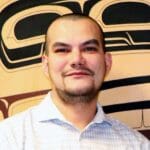The purchase and renovation of a seafood processing facility has created a major economic driver in the coastal community of Lax Kw’alaams. The community-owned company is the biggest employer in Lax Kw’alaams and has played a major role in supporting the fishing industry of the northern waters.
Coast Tsimshian Seafood: How Lax Kw’alaams Shifted to a Sustainable and Locally Owned Fishing Industry
Estimated Reading time

31 Mins
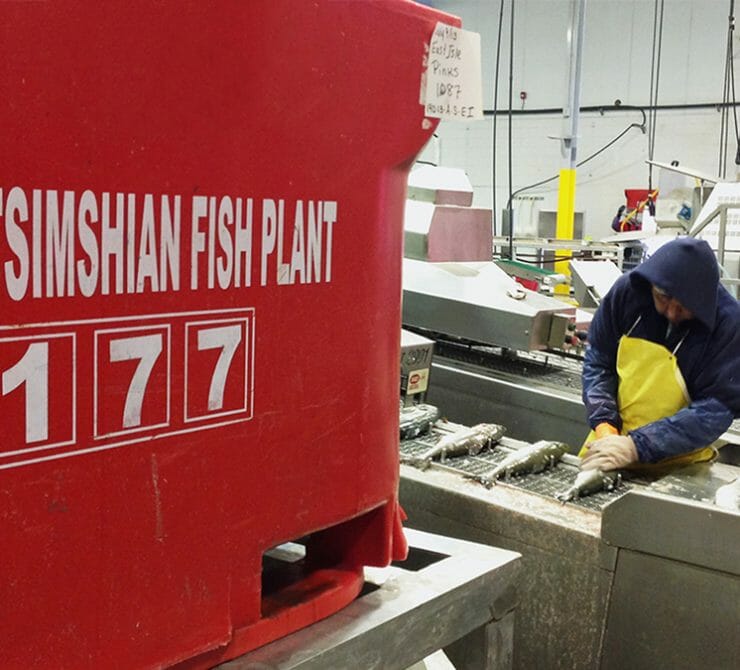
Coast Tsimshian Fish Plant operates out of Lax Kw’alaams, a former camp site of the Gispaxlo’ots tribe, one of the Nine Allied Tribes of Lax Kw’alaams.
At a Glance
For decades the independently owned and operated fish processing facility in Lax Kw’alaams saw a revolving door of outside operators who never managed to keep the business in operation for more than a few years at a time. In 2011, when Lax Kw’alaams Band decided to purchase and invest in major improvements to the facility and its operations, they knew they’d have to do things differently.
With benefits to the community as the bottom-line, and a decision to pivot away from the unreliable Alaskan salmon processing industry toward the more regular and untapped market of groundfish, Coast Tsimshian Fish Plant has become a successful and profitable business. Today, the community-owned company is the biggest employer in Lax Kw’alaams and has played a major role in supporting the fishing industry of the northern waters.
Success Built on an Enduring Relationship with the Ocean
For thousands of years, the wealth of the ocean was a cornerstone of Tsimshian society and economy, and the prolific salmon runs throughout their vast territories were a source of prosperity to the allied Tsimshian tribes.
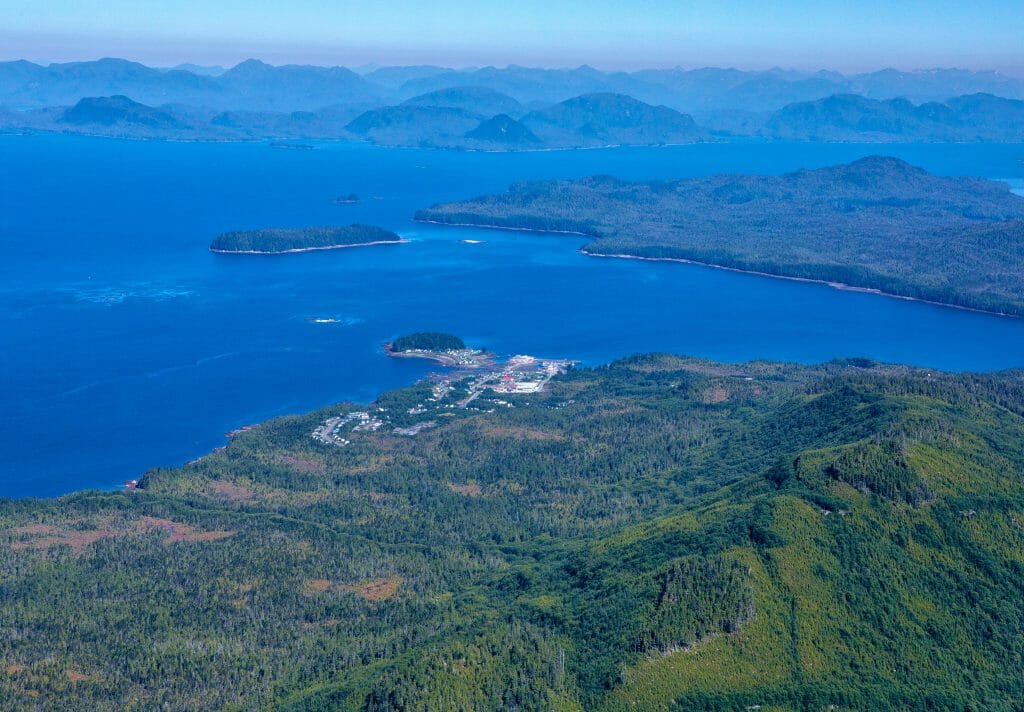
But following prejudicial and extremely restrictive fishing regulations put in place by the colonial government, the Lax Kw’alaams Band was severed from the fishing grounds that had been their primary source of sustenance and economic wealth. The Lax Kw’alaams populations is comprised of the Nine Allied Tribes of the Coast Tsimshian: Giluts’aaw, Ginandoiks, Ginaxangiik, Gispaxlo’ots, Gitando, Gitlaan, Gits’iis, Gitwilgyoots, and Gitzaxlaal.
From 1871 to 1923, First Nations in what would become known as Canada were banned from fishing commercially, but the members of Lax Kw’alaams still found ways to build their wealth and economy from a relationship with the ocean. The community of Lax Kw’alaams—located between two major salmon producing rivers, the Skeena and the Nass—had the highest concentration of Indigenous-owned businesses in the province, including boat building, and clam and salmon canning. (Learn more about Lax Kw’alaams history)

To capitalize on the wealth of salmon in the area, the federal government constructed a fish processing facility in Lax Kw’alaams in the early 1970s. The facility was a key source of employment for community members when it was in operation, but operator after operator failed to achieve long-term success.
“Historically, the fish plant never really turned a profit,” says Carl Sampson, Chief Operating Officer for Lax Kw’alaams Business Development LP. “We’ve had a couple of operators come in, they’d run it for a couple of seasons, they’d lose all their money, they’d pull back out—that was kind of the story for quite a while.”
By the 2000s the facility was perceived by community members as a “white elephant,” with many unsure it could ever be a productive business. So when the government of Lax Kw’alaams considered refurbishing the facility to develop it as an economic driver for the community, they had to ensure they would do things differently from the start and find a way to make it profitable.
Renovations – A Decision to Do Things Differently
The timing was right for Lax Kw’alaams Band to refurbish the fish processing facility located strategically at the heart of the North Pacific fishing grounds. Taking over the facility and its assets was an opportunity to support the community of Lax Kw’alaams by taking advantage of the highly skilled local labour market; many Lax Kw’alaams members had experience working in this facility or ones just like it.
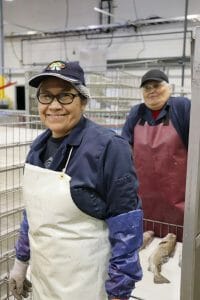
Garry Reece, Mayor of Lax Kw’alaams, points to the skilled workforce as essential to the operation and eventual success of the company. “We have a really good workforce that lives in the community right here,” he says. “And they are really good workers and that’s what makes it operate.”
Despite the skilled labour, council quickly realized it was going to need to undertake major upgrades to the facility in order to make sure it was operating economically. Carl Sampson had just been elected to council in 2011 and was soon faced with the major decision of approving funds to undertake the renovation. “It kind of caught us by surprise,” he recalls. “But we knew the importance of it to the community and to the membership for employment.”
Unlike the third-party operators of the past, this time the renovations and operation of the fish processing facility would be undertaken with the community’s well-being as its primary bottom line. “In the past it was always run by a third-party company or organization and they had their own interests,” says Sampson. “Those don’t always align with the interests of the community. I think taking it into our own hands and putting our interests first was a big success factor for us.”
In the past it was always run by a third-party company or organization and they had their own interests. […] Taking it into our own hands and putting our interests first was a big success factor for us.
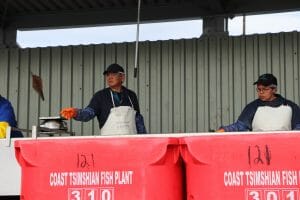
In 2012, Lax Kw’alaams Band Council invested its Coast Funds allocation, and worked with RBC Royal Bank to secure a loan that would finance significant investments in facility improvements throughout Coast Tsimshian Fish Plants’ facility. When it opened its doors as Coast Tsimshian Fish Plant in October 2012 it was the biggest and most technically advanced processing facility in the region, with the capacity to process over 42 million pounds of groundfish and 17 million pounds of salmon each fishing season.
The new equipment, including new freezing and cutting technology, opened up new markets for the fish facility, ensuring that the band would be able to sell groundfish, a previously under-utilized species, to locations in China and the United States. Pivoting to access the groundfish market turned out to be an essential component in the success of Coast Tsimshian Fish Plant.
Community-Based Financing to Support Lax Kw’alaams Fishers
Early in the process of renovation and business development, Lax Kw’alaams councillors recognized a need for alternative financing for fishers in the community. Traditionally in the fishing industry, a large number of fish harvesters will rely on advance payments from large fish processing companies. In return, they can then only sell their product to that particular processing facility, or they are obligated to pay back the advance.
These advances are critical for fishers to support their families through the fishing season, to invest in necessary equipment maintenance upgrades at the start of their season, and for operating capital to finance their business through the fishing season until they make delivery to a fish processing facility.
“A fish company might front you the money in exchange for delivering all your fish to them that year, or getting payback on your loan through your fish,” says Devlin Fernandes, former Director of Community Programs with Ecotrust Canada. “But if you don’t have a good season or maybe you’re not super good at managing your money maybe at the end of the season you might still be indebted to that company. So you have to go back the next year and it just becomes this endless cycle.”
Lax Kw’alaams Councillors recognized this could create a supply issue for Coast Tsimshian Fish Plant, and approached Ecotrust Canada with an idea for an alternative financing program that would support Lax Kw’alaams fishers, and benefit Coast Tsimshian by ensuring a steady supply of fish.

Ecotrust Canada had previously operated a Coastal Loan Fund that aimed to deliver social, economic, environmental, and cultural benefits to coastal communities.
Though they weren’t delivering a loan program at the time, they saw the benefit alternative financing could provide to the community of Lax Kw’alaams. “Everyone could see the benefits of [fish harvesters] delivering to their community fish facility. It would not only provide pride, and more money circulating in the community, but there would be more jobs, more people at the fish facility, so there’d be more shore-based jobs as well as on the water jobs.”
Working with a contribution from a donor through Tides Canada, Ecotrust Canada partnered with Lax Kw’alaams to develop a fund that would support local fish harvesters. In 2016, Lax Kw’alaams Band and Ecotrust Canada worked with Community Futures Pacific Northwest on the Fish for Community loan fund.
Today the Fish for Community loan fund has been almost entirely distributed and has supported approximately a dozen fishers from Lax Kw’alaams, says Eli Kelly, a Lax Kw’alaams member who manages Fish for Community for Community Futures. Most of those loans help get fishers started at the beginning of each year by enabling them to purchase supplies and fuel for their boats. Kelly points out that one of the important elements of the fund is how much lower barrier it is than a traditional bank loan.
“It is very difficult for commercial fishermen to get loans from a bank, and it is especially difficult for commercial fishermen to get loans who are living on reserve, such as in Lax Kw’alaams,” he says. “Banks don’t work with a lot of these fishermen for these small deals.” The Lax Kw’alaams loan fund was specifically designed to be able to take into consideration factors other than down-payment and security. “I think we offer a great alternative to [bank loans] because it’s about character and viability and who the fisherman is, and just trying to support them in these tiring times,” says Kelly.
It is very difficult for commercial fishermen to get loans from a bank, and it is especially difficult for commercial fishermen to get loans who are living on reserve, such as in Lax Kw’alaams.
To be able to assess those factors, Kelly works closely with Lax Kw’alaams Band. “It is still very much an active joint partnership,” says Kelly. He usually connects with the staff at Lax Kw’alaams Business Development to gain a reference of a fisher if it is someone Kelly hasn’t worked with in the past. “They’re a good connection to get that finger on the pulse of what’s actually going on in community, what are these guys doing, how’s the season going. So we kind of work together like that,” says Kelly.
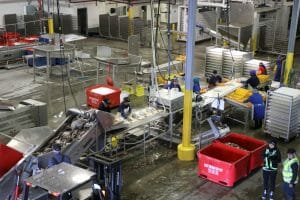
Fernandes notes that, along with support benefits in Lax Kw’alaams, the fund was designed with the intention that it could be a model applied in other coastal communities. “There were other fish plants—such as the one in Bella Bella, the Heiltsuk Nation who wanted to try and retain more of those dollars locally, and there were also areas where there were harvesters who were indebted to other companies and didn’t have the autonomy or ability to sell where they needed to,” she says.
Kelly notes that the fund hasn’t yet been able to expand beyond Lax Kw’alaams, but says it is a long-term goal. Now that they are learning more each year about best practices for supporting community fishers, Community Futures hopes to see the fund grow to support bigger loans and other communities. “We are definitely open to looking at other places and retreading that, but I want to make sure we have a good model first,” says Kelly.
Supporting the Community and Maintaining an Industry
While it was planning for the renovation, Lax Kw’alaams Band realized it would have to pivot its business model if it wanted to be successful. The company had previously relied largely on salmon processing, but quickly began expanding the amount of groundfish it was processing each season.
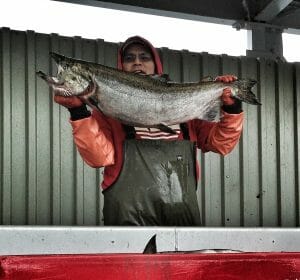
Sampson notes that a key learning for the company has been understanding that salmon runs aren’t as reliable as they might have been in the past. “If the salmon is not going to show up, we want to make sure there’s still a steady supply of groundfish coming through,” he says.
By adding groundfish—such as cod, sole, Arrowtooth flounder, turbot , pollock, and skate—the company is able to extend its season of operation to run from a target start date of April 1 right up until December. The longer and more consistent operating season means greater employment for members of Lax Kw’alaams Band.
Garry Reece, Mayor of Lax Kw’alaams, notes just how important the company and its facility is for his community, employing from 65 during the regular season to 110 people at its peak season. “It’s the biggest employer in the community and every year it puts probably a million dollars into wages for the local membership, so it’s very important to our local economy in the village.”
It’s the biggest employer in the community and every year it puts probably a million dollars into wages for the local membership, so it’s very important to our local economy in the village.
That income makes all the difference in a remote community like Lax Kw’alaams. “They got a steady income and they’re able to be proud,” said former Lax Kw’alaams Mayor, John Helin, in a CBC article. “You have to have a job, you have to have self-worth, and that’s huge for anybody, to be able to provide for your family.”
While they were co-developing the alternative financing fund for fishers, Devlin Fernandes recalls speaking with employees of Coast Tsimshian Fish Plant and seeing a sense of ownership and satisfaction at the success of the operation. “There was such pride about having a driver in the economy and a place where people could go to work, see family members doing well, getting a variety of different skills,” she says.
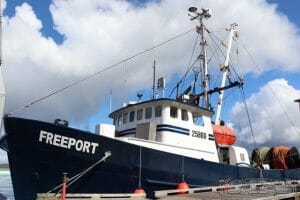
Beyond the benefit of local employment, the success of Coast Tsimshian Fish Plant is benefiting the larger fishing industry in the region. The main source of groundfish for the facility comes from the million-pound quota of the MV Freeport, a 24-metre trawler owned and operated by Lax Kw’alaams Fishing Enterprises, whose crew are made up entirely of Lax Kw’alaams members. In addition, the Band has been investing in a second trawler to supply the processing facility, called the MV Nucleus, which they intend to have 75 per cent ownership in by the end of 2019.
Garry Reece and Carl Sampson both point out how the company and the Band have been able to develop relationships with other fishers in the region, which helps provide supply to keep the Coast Tsimshian Seafood facility running, and supports the fishing industry as a whole.
Having a fish processing facility in the northern part of the province helps maintain the ground fishing industry, says Sampson. Other processing operations in the region are going out of business, and so a lot of fishers in the region are shifting toward Coast Tsimshian Fish Plant in Lax Kw’alaams now.
“It’s the only processing facility on the north coast,” says Garry Reece. “The big ones in Prince Rupert have all shut down or moved where it’s cheaper to operate.”

Sampson suggests that by having a seafood processor on the north coast, it keeps fishing boats in the region. “If there’s no processor up here there’s less likely to be boats up here fishing for their quota because they’d have to go all the way back down south to deliver,” he says.
The company is undoubtedly a success for the community and for the band, says Mayor Reece. “We’ve turned it from a money loser into making a little bit of money every year. It’s a very good story for the community.”
We’ve turned it from a money loser into making a little bit of money every year. It’s a very good story for the community.
Challenges and Lessons Learned
Carl Sampson acknowledges the renovation and operation of Coast Tsimshian Fish Plant has been a long learning process. “We’re constantly learning, we’re always learning something new every day,” he says. Looking back on the years that have passed since council made the decision to purchase and renovate the facility, he’s confident in pointing to a few key lessons.
Community Benefits are the Bottom Line

Sampson says it was important for the Lax Kw’alaams Band that Coast Tsimshian Fish Plant be run as an effective business, but he points out that its success is due largely to its focus on providing benefits to the community. Whereas other seafood processing companies might focus exclusively on maximizing their return on investment, for Lax Kw’alaams, the community is the priority. “Other companies might be looking at maybe how they can put their money into a different operation, a different region, or a different country,” says Sampson. “But we’re invested in our community, we’re invested in our region, we’re here for the long haul.”
Diversifying and Adapting to Change
One of the key reasons for the success of Coast Tsimshian Fish Plant was transitioning from a facility that processes only salmon, to one that focuses largely on groundfish. “It always was a challenge to get salmon to our fish plant even though there were fisheries,” says Mayor Reece. “So it’s always been a challenge to try and diversify what we can do with the fish plant.”
As well as providing a longer employment season for residents of Lax Kw’alaams, this also served to increase the profitability of the company by opening up access to new markets globally.
Marketing
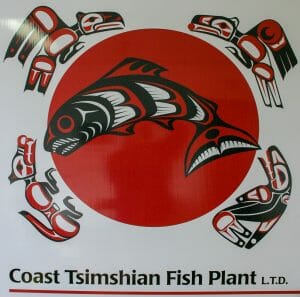
Another ambition for the business is to play a more active role in the marketing of its product. Coast Tsimshian Fish Plant has previously relied on brokers to sell the fish, and wasn’t able to market it themselves. But Sampson sees an opportunity to add more value to the product by marketing it more strongly. “Because it is a First Nations product, all of our employees are First Nations, and it’s a First Nations-owned company, I think that adds a lot of value for branding.”
Building up Secondary Industry
One of the challenges Sampson and his team at the Lax Kw’alaams Business Development faces, is building up a secondary industry around the company’s operations.
Sampson recognizes the importance of growing the small business sector, and is prioritizing it in the coming years. “We’ve been working on trying to get these small businesses going in our community. We’ve delivered a few training sessions now for entrepreneurship,” he says. Community members have been exploring ideas such as establishing a food truck business.
Social Outcomes
The company is a major employer in Lax Kw’alaams, employing as many as 110 people during its peak season, all of whom are First Nations. During its renovation and launch, the business also trained a number of staff: 30 staff received a total 50 days of training in areas such as first aid and forklift operation.
In an article from the Northern View, Robert Hughes, a Lax Kw’alaams councillor, pointed out how significant this employment is for the community. “This is a landmark for the Lax Kw’alaams,” said Hughes. “Nearly all of the employment age band members living at Lax Kw’alaams are now working with the fishery in one form or another. The fishing economy is providing a sustainable way for the band to support itself.”
By increasing the length of time it is in operation each year, the company is able to increase salaries for community members. “Now that we’re able to stay open till December, that annual income for the worker is a lot higher than what it was traditionally,” says Sampson. “And we’ve been able to get a lot more of our members and a lot more of our employees onto employment insurance for their off season, which makes a huge difference in their quality of life.”
Learn more about job creation outcomes.
Cultural Outcomes
Lax Kw’alaams is a coastal community, with deep ties to the surrounding marine environment. The seafood processing facility provides a way for community members to develop and strengthen their connection with marine resources, either through fishing or processing. Many Elders in the community are skilled fish processors, and the company’s operations allows a way for them to pass that knowledge to younger community members.
By providing family-supporting jobs through the facility, Lax Kw’alaams Band is able to encourage more members to stay in Lax Kw’alaams, rather than having to move away to larger communities to make a living. This means children are growing up immersed in their own culture and making connections with Elders in the community. Sampson notes that retaining community members in Lax Kw’alaams remains a primary focus for the Band, which is why having such a large employer is so critical to the cultural well-being of community members.
Learn more about Elders and youth outcomes.
Environmental Outcomes
In addition to complying with provincial environmental standards governing seafood processing facilities, Coast Tsimshian Fish Plant also works with the Groundfish Development Authority to ensure fishing practices are sustainable.
Coast Tsimshian Fish Plant’s website states “Our company follows resource management practices provided for within Tsimshian traditional law—sustainability that dates back more than 15,000 years. The fish are wild and First Nation caught with a minimum seven generation planning cycle.”
Learn more about environmental outcomes.
Economic Outcomes
Coast Tsimshian Fish Plant has integrated with the Lax Kw’alaams Fishing Enterprises, another band-owned corporation, ensuring mutual benefits to both corporations. Fishing vessels like the Freeport have a market for their fish, and Coast Tsimshian Fish Plant has a steady supply of groundfish to keep the facility running throughout the year.
The benefits to the fishing industry extend beyond the Freeport to other local vessels, thus helping to buoy the entire north coast industry at a time when other processing companies are shutting down.
The community-owned company has also maintained a number of important partnerships in its recent years of operation. In addition to the Lax Kw’alaams Fishing Enterprises (local community fishers), Coast Tsimshian Fish Plant has also developed working relationships with other industry players such as Fisher Bay Seafoods, North Delta Seafoods, Canfisco, and others.
Learn more about partnership outcomes.
Between 2012 and 2015, Coast Economic Development Society approved funding of $1,500,000 for the redevelopment, start-up, and operation of Coast Tsimshian Fish Plant.
Online Resources
- Coast Tsimshian Seafood
Coast Tsimshian Seafood Website - Lax Kw’alaams Band
Lax Kw’alaams Band Website - The Allied Tribes Tsimshian of North Coastal British Columbia: Social Organization, Economy and Trade
Margaret Seguin Anderson, Ph.d., June, 2006 - Historical Timeline
Union of BC Indian Chiefs - Lax Kw’alaams History
History of Lax Kw’alaams Band - 'Open for business': How the Lax Kw'alaams First Nation revitalized forestry in B.C.'s northwest
CBC, May 2018 - State-of-the-art First Nation fish plant brings jobs, hope for prosperity to north coast
Vancouver Sun, October 2012 - Coast Tsimshian Seafood Major Employer for Lax Kw’alaams
Coast Funds, May 2018 - Lax Kw’alaams plant hits payroll milestone
The Northern View, September 2013 - Lax Kw’alaams First Nation
Indigenous Business and Investment Council - Lessons Learned from Our Coastal Loan Fund
Ecotrust Canada, 2011 - Fish Plant Yields Returns For First Nation
BC Business, September 2013 - Community Futures Pacific Northwest
Community Futures Pacific Northwest
Published On December 18, 2019 | Edited On January 13, 2023
